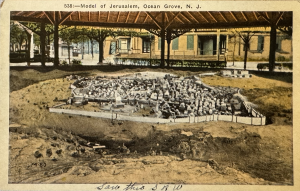It’s been almost two centuries since the prominent American Jew Mordecai Manual Noah attempted to establish a homeland and refuge for the beleaguered Jews of the world in, of all places, Grand Island, N.Y.
Noah went so far as to lay a cornerstone in 1825 for the intended nation of Ararat, named after the spot where the biblical Noah’s ark landed. However, the world’s Jews failed to notice and Ararat was relegated to near-oblivion, a quirky episode in the saga of Jewish nationalism before Zionism caught on at the end of the 19th century.
Ararat has been the subject of many historical articles and several books, most notably Ben Katchor’s 1999 graphic novel, The Jew of New York. Renewed attention has been paid to the story recently due to the efforts of Toronto-based artist Melissa Shiff, who has spearheaded a “Mapping Ararat” project to bring a new level of realism to Noah’s near-forgotten dream.
Using an app on their iPods or iPhones, visitors to the Grand Island site, near the corner of Whitehaven and East River roads may use their devices to see various imagined elements of Ararat – including a flag, port of entry, cornerstone and synagogue – inserted into the landscape. Plaques and video and audio files pop up, offering more information as visitors approach each element.
Shiff, who recently gave some group tours at the site, draws a parallel to the literary genre of alternate or “counter-factual” histories as employed by Philip Roth in The Plot Against America and Michael Chabon in The Yiddish Policeman’s Union which takes place in an invented Jewish homeland in Alaska.
“In the literary world it’s quite an established form, but in the visual art world, it really isn’t,” Shiff said, adding that in the art world, it’s rare for an augmented reality project to be as extensive as Mapping Ararat. The project was conceived by Shiff and supported by a $62,000 grant from the Social Sciences and Humanities Research Council of Canada (SSHRC). The creative team also included her husband Louis Kaplan, who, like Shiff, is an academic at the University of Toronto, and technological adviser John Craig Freeman.
Living in New York for a year while Kaplan is on sabbatical there, Shiff and her team have lectured about the project “non-stop” at academic conferences and other gatherings, she said. She and Kaplan were keynote speakers at a recent conference at Rutgers University on contested memory.
Mapping Ararat “appeals to many different circles,” she said. “You have the technofiles who want to hear about such an extensive project – a lot of augmented reality projects are not extensive like this; I think this is the first project of this kind that has this kind of scope. It also links into Jewish history circles and comparative literature circles and ethnographic circles. There are many communities that are interested in it.”
While the funding for the project runs out in May, Shiff has already applied to SSHRC for new funding for more such projects. “The subtitle of the project is ‘Imaginary Jewish Homelands,’ so we’re certainly considering other proposed homelands,” she said. While Alaska, where Chabon’s novel is set, won’t be one of them, other potential localities include Suriname and the Kimberley and Tasmania region of Western Australia.
Besides the architectural renderings, Shiff has also designed a range of pop-culture pieces as if history had taken a bizarre turn and Ararat had actually come into existence. They include a postage stamp, postcards, movie poster and an Ararat dollar bill.
Might not someone possibly mistake one of these invented items as a real artifact? “Oh, that’s already happened,” she acknowledged with a laugh. “They were inducting Mordecai Noah into the American Jewish Hall of Fame and they happened to come across the dollar bill I designed, and they wanted to know if it was real.”






